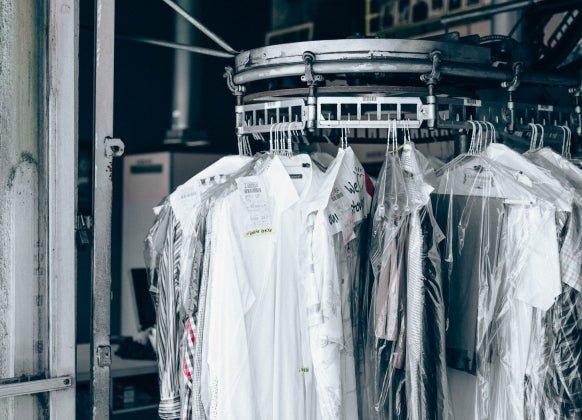“Dry cleaning” process is neither “dry” nor “clean.” It is not a "dry" process as the clothes are soaked in harmful liquid solvent. And it is neither a “clean” process as the whole process directly harms the workers dry cleaning your clothes, puts pressure on the environment and it isn’t good for you either.
How many of us are aware of the Dry-cleaning symbols, when buying a pair of clothes?
Let us understand dry cleaning process, to understand the meaning of these symbols.

Dry cleaning (commonly called Petrol wash in India) as we all know is a process of using chemical solvents to clean clothes, rather than water. Contrary to the popular advertisements that say, dry-cleaning saves water, it actually has a higher carbon footprint. The narration makes you believe, its useful for delicate fabrics that would not withstand being tossed around in washing machine, or fabrics that bleed dyes. It is in fact a common practice in India to dry clean expensive silk sarees for preventing any damage to the delicate thread work. However, it is also common to get clothes dry cleaned to get rid of any minor stains (although this is more of a myth). Unfortunately, few people somehow consider it as a privilege and take pride in maintaining clothes that have a “Dry Clean Only” tag. But do you know what is actually happening to your garments when you get it ‘petrol washed’? Before we get into the facts of how it affects the environment, lets understand what it is and what it does to you!
The dry-cleaning process involves a number of harmful chemicals including solvents, grease and most importantly Perchloroethylene (PERC) or Tetrachloroethylene. It is commonly called dry cleaning fluid, which is colourless hydrocarbon chemical and has a sweet odour, but highly toxic. PERC has been a standard dry-cleaning solvent for many decades, since it is commonly available and cheap. The usage of PERC is widespread not just in India, but worldwide too including the USA. Since this industry is unorganized, most dry cleaners simply use these toxic chemicals that are commonly available in the market and they themselves don’t know how dangerous they are.
However, many studies have shown how dangerous PERC is for human health and for the environment. It is classified as Group 2A (i.e. probable) carcinogen by International Agency for research on Cancer & EPA (Environmental Protection Agency). There is a lot of debate on its “likely human carcinogen” status, meaning that prolonged exposure to the chemical has been linked to an increased risk of cancer. Since, it is volatile chemical, it enters the body through respiration or though skin, and is a central nervous system depressant. Thus, the personnel working in such conditions are most prone to the adverse effects. To add, as per a study conducted by Georgetown University, PERC stays in the clothes even after the dry-cleaning process is over, which means that you may come in contact with this chemical too. Exposure to hazardous chemicals commonly used in dry cleaning shops may occur through skin absorption, eye contact, or inhalation of the vapours. Exposure leads to symptoms of depression of the central nervous system; damage to the liver and kidneys; impaired memory; confusion; dizziness; headache; drowsiness; and eye, nose, and throat irritation. Repeated dermal exposure may result in dermatitis.
In many developed countries, real estate around the dry-cleaning facilities are cheapest, owing to the chemical, fire and ergonomic related hazards it will have on the nearby community. Special areas are allocated for these facilities. In India, all our dry-cleaning facilitators simply outsource clothes to a central facility in the locality. Not every facilitator has his own set up and hence, it is highly fragmented and unstructured, with very few players actually adopting modern methods. There are other hydrocarbon chemical alternatives to PERC, but are more expensive. Thus, they are not used by a vast majority of dry cleaners across the country. Thus, it is not commonly known to a layman that dry cleaning process is extremely harmful to the environment and to the personnel handling the process too.
Now, what does this all mean to the environment? It is also a common soil and air contaminant. Since it is soluble in water, it is very easy for this chemical to reach ground water bed too, and any clean up activity for accidental spillage is more difficult than oil spills. Thus, any dry-cleaning plant in the neighbourhood may most likely cause contamination of ground water supply. Further, since it is volatile, almost 85% of the PERC that is produced ultimately gets released into the air, traces of which can be found in the air far away from the laundry facilities as well. Also, do not forget about all those fancy stores, who wrap all your clothes in plastic and deliver at your door steps adding up to the external emissions.
So, are there really alternatives for Dry Cleaning?
First of all, we must note that most of the natural fibers can be washed in water at home with gentle care. But some synthetics like viscose, lyocell, cupro, and modal react poorly with water and must be dry-cleaned. These synthetic clothes must be avoided by us anyway for the environmental impact, right? Read about the different types of fabric. So, it really starts with rethinking and planning your wardrobe, which we have elaborated in this article.
Dry cleaning could be essential to you at times like oil stains, but not always. In case you really need this service, there are many ways to take care of your clothes other than these toxic chemicals. Firstly, there are tons of videos on the internet for DIY cleaning at home for all types of fabrics like raw silk, wool, etc. For lightly used clothes, steaming of clothes is effective for removal of bacteria and odour. Some fabrics can also be cleaned easily by spraying vodka. Reetha (Soap berries) is effective for washing silk sarees. If all of these do not help, look around for a service for an environmentally friendly dry cleaners that have started adopting modern methods like CO2 cleaning or wet cleaning.
Wet cleaning is a process of sensitively cleaning the garment which is gentler than home washing without using hazardous chemicals and using mild laundry products along with steaming and pressing methods. Thus, its energy efficient, doesn’t generate toxic waste or air pollution. It is gentler on fabrics and therefore, extends their life. It safely cleans wool, silks, cashmere, linens and other delicate fabrics. This advantage of this start up is lowered costs of capital, raw materials, equipment and hazardous waste disposal along with less reliance on skilled labor. The biggest disadvantage of wet cleaning however is clothes may shrink or get a little distorted in colour in the process. It isn’t effective on oil stains as well.
CO2 dry cleaning uses natural liquid carbon dioxide. This CO2 can be recycled from different industries. And is combined with recyclable cleaning agents which washes the dirt, particulates, stains and toxins from garments, then flushes and "dries" using CO2’s state changing cycles from a gas to a liquid and then back to a gas. The entire cleaning process is done at a cool, room temperature. However, is a bit expensive set up to begin with.

Many rental platforms also promote their products as eco friendly & sustainable although they dry clean after every use. "Rent the Runway" is one such platform that came under scrutiny for such a flawed model.
Now imagine this, while you purchase the most sustainable garment with organic cotton or natural dyes, sustainably manufactured and made by an artisan who receives fair wages, but comes with a tag “Dry Clean Only”. Would you really think you are making a sustainable purchase?





